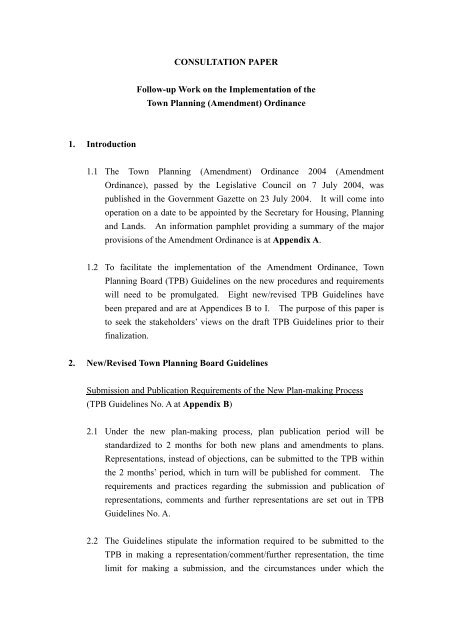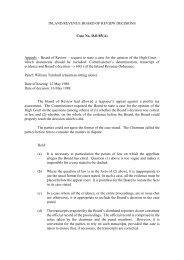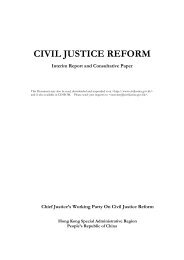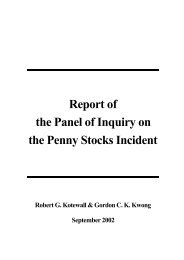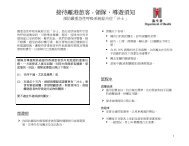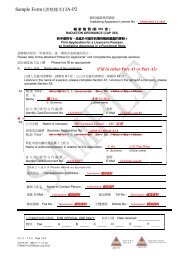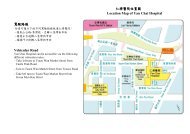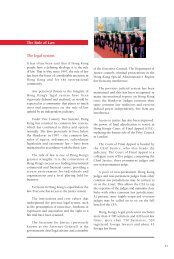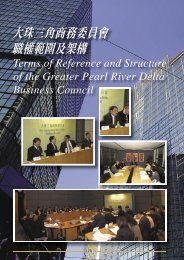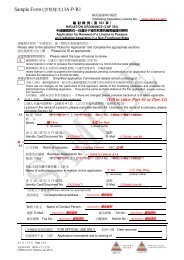Amendment
Amendment
Amendment
Create successful ePaper yourself
Turn your PDF publications into a flip-book with our unique Google optimized e-Paper software.
CONSULTATION PAPER<br />
Follow-up Work on the Implementation of the<br />
Town Planning (<strong>Amendment</strong>) Ordinance<br />
1. Introduction<br />
1.1 The Town Planning (<strong>Amendment</strong>) Ordinance 2004 (<strong>Amendment</strong><br />
Ordinance), passed by the Legislative Council on 7 July 2004, was<br />
published in the Government Gazette on 23 July 2004. It will come into<br />
operation on a date to be appointed by the Secretary for Housing, Planning<br />
and Lands. An information pamphlet providing a summary of the major<br />
provisions of the <strong>Amendment</strong> Ordinance is at Appendix A.<br />
1.2 To facilitate the implementation of the <strong>Amendment</strong> Ordinance, Town<br />
Planning Board (TPB) Guidelines on the new procedures and requirements<br />
will need to be promulgated. Eight new/revised TPB Guidelines have<br />
been prepared and are at Appendices B to I. The purpose of this paper is<br />
to seek the stakeholders’ views on the draft TPB Guidelines prior to their<br />
finalization.<br />
2. New/Revised Town Planning Board Guidelines<br />
Submission and Publication Requirements of the New Plan-making Process<br />
(TPB Guidelines No. A at Appendix B)<br />
2.1 Under the new plan-making process, plan publication period will be<br />
standardized to 2 months for both new plans and amendments to plans.<br />
Representations, instead of objections, can be submitted to the TPB within<br />
the 2 months’ period, which in turn will be published for comment. The<br />
requirements and practices regarding the submission and publication of<br />
representations, comments and further representations are set out in TPB<br />
Guidelines No. A.<br />
2.2 The Guidelines stipulate the information required to be submitted to the<br />
TPB in making a representation/comment/further representation, the time<br />
limit for making a submission, and the circumstances under which the
2<br />
representation/comment/further representation will be considered as invalid.<br />
Relevant forms are being prepared to facilitate the representer, commenter<br />
and further representer in complying with the submission requirements.<br />
2.3 All the information submitted (including name, but excluding<br />
correspondence address, and telephone number/fax number/email address)<br />
will be available for public inspection at the two Enquiry Counters (one in<br />
North Point and one in Shatin) of the Planning Department (PlanD). To<br />
inform the public of the deadline for submission and the arrangement for<br />
public inspection of the submission, notices will be published in newspapers,<br />
uploaded to the TPB’s website, and posted at the TPB Secretariat, the<br />
relevant district planning office (DPO), district office (DO) and, where<br />
appropriate, Rural Committee (RC).<br />
2.4 The notification of decision arrangements will generally follow the existing<br />
practice.<br />
Submission and Publication Requirements of Various Applications<br />
(TPB Guidelines No. B at Appendix C)<br />
2.5 Under the <strong>Amendment</strong> Ordinance, all planning applications (i.e. planning<br />
applications and applications for amendment to statutory plans), except<br />
those made under section 16A for Class B amendments to approved<br />
development proposals, will be published for public comment. TPB<br />
Guidelines No. B set out the general practices and requirements regarding<br />
publication of applications for amendment of plans, planning permission<br />
and review, as well as submission of comments on such applications.<br />
2.6 Similar to the plan-making process, all information submitted (including<br />
name, but excluding correspondence address, and telephone number/fax<br />
number/email address) in connection with the various applications (except<br />
those made under section 16A) will be made available for public inspection<br />
at the two Enquiry Counters of PlanD. To inform the public of these<br />
applications, the deadline for submission of comments and the arrangement<br />
for public inspection, notices will be published in newspapers or posted in a<br />
prominent position on or near the application site. Notices will also be<br />
uploaded to the TPB’s website, and posted at the TPB Secretariat, the<br />
relevant DPO, DO and, where appropriate, RC.
3<br />
2.7 As an administrative practice, notices will also be sent to the Owners’<br />
Corporations or, where appropriate, other management committees of<br />
buildings within 100 feet (around 30m) of the application site. For<br />
applications of territorial or major local interest, notice may be mounted on<br />
roadside railing.<br />
2.8 Similar to the plan-making process, forms will be prepared/revised to<br />
facilitate the applicant in complying with the submission requirement.<br />
The ‘Owner’s Consent/Notification’ Requirements<br />
(TPB Guidelines No. C at Appendix D)<br />
2.9 The <strong>Amendment</strong> Ordinance requires that in submitting an application for<br />
amendment of plan or planning permission, the applicant should obtain<br />
owner’s consent, or notify the owner, or take such reasonable steps the TPB<br />
may require to obtain consent or give notification to owner on such<br />
application. TPB Guidelines No. C provide guidance on the interpretation<br />
of ‘current land owner’, the required documentary proofs and how the<br />
‘owner’s consent/notification’ requirements can be satisfied.<br />
2.10 ‘Current land owner’ is defined in the <strong>Amendment</strong> Ordinance as “any<br />
person whose name is registered in the Land Registry as that of an owner of<br />
the land to which the application relates, as at the commencement of such<br />
period before the application is made as is specified by the TPB by notice<br />
published in the Gazette.” To cater for owners of new transaction pending<br />
formal registration and taking into account the practice of Land Registry in<br />
processing registration of land document, it is recommended to specify<br />
‘such period’ as ‘4 weeks’ before the application is made. In satisfying<br />
this requirement, a more updated record of owner registered in the Land<br />
Registry will also be accepted.<br />
2.11 In making an application, an applicant has to submit a full set of the<br />
relevant Land Registry records and to provide:<br />
(a) the statement of consent signed by each and every ‘current land<br />
owner’; or
4<br />
(b) the record of notification to prove that he has sent by registered mail or<br />
local recorded delivery mail to the ‘current land owner’ and submit<br />
the record of owner’s notification; or<br />
(c) evidence to demonstrate that he has taken such reasonable steps as<br />
(i)<br />
sending (e.g. mail record) the statement of consent to the<br />
‘current land owner’; or<br />
(ii)<br />
publishing a notice of the application once in two Chinese and<br />
one English local newspapers; and either posted a notice in a<br />
prominent position on or near the application site, or sent a<br />
notice of the application by post to the Owners’ Corporation(s)<br />
or, where appropriate, other management committee(s) of the<br />
building(s) erected on the application site or the relevant Rural<br />
Committee(s).<br />
The TPB may require the applicant to take other reasonable steps in<br />
satisfying the “owner’s consent/notification” requirements as circumstances<br />
require.<br />
2.12 The <strong>Amendment</strong> Ordinance also stipulates that the applicant should comply<br />
with the ‘owner’s consent/notification’ requirements within a reasonable<br />
period before the application is made. What constitutes a ‘reasonable<br />
period’ will depend on individual circumstances of each case, taking into<br />
account the justifications to be provided by the applicant. In general, one<br />
year before the application will be taken as the reasonable validity period of<br />
the owner’s consent/notification, provided that such owner remains to be<br />
the ‘current land owner’.<br />
2.13 In accordance with section 40(2)(c) of the Interpretation and General<br />
Clauses Ordinance (Cap. 1), the TPB may withdraw its decision on an<br />
application if the applicant is found to have made any false declaration or<br />
statement on the application. Any person who knowingly or wilfully<br />
makes a false declaration or statement would be liable to prosecution under<br />
the Crimes Ordinance (Cap. 200), the Oaths and Declarations Ordinance<br />
(Cap.11) and/or other relevant Ordinances.
5<br />
Submission of Further Information<br />
(TPB Guidelines No. D at Appendix E)<br />
2.14 Under the <strong>Amendment</strong> Ordinance, the applicant may submit further<br />
information to supplement an application for amendment of plan, planning<br />
permission and review. The TPB may, under section 2(5)(c) of the<br />
<strong>Amendment</strong> Ordinance, delegate to the Secretary of the TPB its power to<br />
determine acceptance of further information. TPB Guidelines No. D set<br />
out the general practice in dealing with further information submitted by an<br />
applicant.<br />
2.15 Further information may generally be divided as follows:<br />
(a) those which will result in a ‘material change’ to the nature of the<br />
application, and thus submission of a fresh application will be required;<br />
(b) those which will be acceptable for inclusion into the application, but<br />
publication of such additional information for public comment will be<br />
required and thus the statutory time limit for consideration of the<br />
application will be re-counted from the date when the further<br />
information is received; and<br />
(c) those which will be acceptable for inclusion into the application, but the<br />
information submitted is so minor in nature that such type of<br />
information could be exempted from publication requirement, and the<br />
application together with the further information will be submitted to the<br />
TPB for consideration as originally scheduled.<br />
2.16 The general criteria for assessing the various types of information are<br />
proposed as follows:<br />
(a) a ‘material change’ is involved if the further information will lead to,<br />
for example, (i) a change exceeding 10% in the proposed plot ratio,<br />
gross floor area, site coverage or building height of the original scheme,<br />
(ii) in the case of applications for amendment of plan, a major change<br />
in site area or boundary, the proposed zoning, uses and development<br />
restrictions, (iii) in the case of applications for planning permission, a<br />
major change in the area and configuration of the application site,
6<br />
proposed use, design and layout of the proposed scheme and nature of<br />
approval sought; and<br />
(b) the accepted further information may be exempted from publication<br />
requirement if it relates to clarification of background or technical<br />
information, rectification of editorial errors, or minor changes in the<br />
proposed scheme in terms of internal layout, location of open space,<br />
form and disposition of building, etc.<br />
Any accepted further information not falling within (a) or (b) above will be<br />
published for public comment.<br />
2.17 Representation, comment and further representation made to the TPB after<br />
expiration of the relevant statutory time limits shall be treated as not having<br />
been made. It is the duty of the representer, commenter and further<br />
representer to provide sufficient information when making submission to<br />
the TPB. Under the Ordinance, there is no provision for the TPB to accept<br />
further information from the representer, commenter and further representer<br />
after the expiry of the relevant statutory time limits for making submission.<br />
Processing of Request for Deferment<br />
(TPB Guidelines No. E at Appendix F)<br />
2.18 TPB Guidelines No. E set out the general procedures and practices in<br />
considering request for deferment on decision on representations, comments,<br />
further representations and applications The TPB may, under various<br />
circumstances or upon request, defer its decision on the submissions to<br />
another date.<br />
2.19 Reasonable grounds should be provided to support the request for deferment.<br />
The deferment should not be indefinite, and further deferment will only be<br />
granted under very special circumstances. The TPB may, upon<br />
consideration of such request or of its own volition, decide to defer the<br />
decision on an application on the following grounds:<br />
(a) further consultation with relevant Government departments is required;<br />
(b) supplementary information which is essential for the consideration of
7<br />
the submission is required, but not yet available;<br />
(c) recommendations of major Government planning-related study or<br />
infrastructure proposal which may have significant planning<br />
implications on the application site is due to be released; or<br />
(d) any other reasonable grounds as the TPB thinks fit.<br />
2.20 The decision on the applications may also be deferred where the TPB<br />
accepts submission of further information to supplement the applications<br />
and the consideration date has to be rescheduled, or if the zoning of the<br />
application site is still subject to outstanding adverse representation yet to<br />
be submitted to the Chief Executive in Council (CE in C) for consideration.<br />
2.21 However, in the plan-making process, submission of further information is<br />
not provided for as explained in paragraph 2.17 above. Requests for<br />
deferment of representation hearing will normally not be entertained as it<br />
may affect other parties involved in the hearing and there is a tight statutory<br />
time limit of 9 months for the submission of the draft plan to CE in C for<br />
consideration. If the deferment is absolutely unavoidable, the TPB may<br />
grant a deferment up to a maximum period of 4 weeks, taking into account<br />
all relevant considerations and circumstances of each case. The<br />
procedures for handling requests for deferment are set out in the Guidelines.<br />
Renewal of Planning Approval and Extension of Time for Compliance with<br />
Planning Conditions for Temporary Use<br />
(TPB Guidelines No. F at Appendix G)<br />
2.22 Planning permissions for temporary uses are granted for a specific approval<br />
period and in most cases, time-limited conditions are also imposed for<br />
submission and implementation of improvement measures associated with<br />
temporary open storage and port back-up uses in the New Territories. TPB<br />
Guidelines No. F set out the application procedures and assessment criteria<br />
for applications for renewal of planning approval and for extension of time<br />
for compliance with planning conditions for temporary uses.<br />
2.23 While all applications for renewal of planning approval for temporary uses<br />
will be processed under section 16, a streamlined approach in respect of the
8<br />
submission requirements is recommended to be adopted. If there is no<br />
major change in planning circumstances since the last approval of the<br />
application, the applicant will not be required to prepare new, but just the<br />
updates of, technical assessments to support the application.<br />
2.24 An application for extension of time for compliance with planning<br />
conditions for temporary useswill fall within Class B amendments and shall<br />
be made in accordance with section 16A. Under no circumstances should<br />
the extension of time for compliance with planning conditions exceed the<br />
original validity period of the temporary approval. Such application<br />
should be submitted no less than 4 weeks before the expiry of the specified<br />
time limit. The planning permission will be revoked if the planning<br />
conditions are not compiled with by the specified time limit and no<br />
application for extension of time has been received or approved. Under<br />
such circumstances, a fresh section 16 application in accordance with the<br />
provision of the extant statutory plan will be required.<br />
2.25 The assessment criteria for such applications are similar to those stated in<br />
the current TPB Guidelines No. 21A.<br />
Extension of Time for Commencement of Development<br />
(TPB Guidelines No. G at Appendix H)<br />
2.26 Planning permissions for most of the permanent developments are subject to<br />
a time-limited condition requiring the development be commenced by a<br />
specified date. TPB Guidelines No. G set out the application procedures<br />
and assessment criteria for processing applications for extension of time for<br />
commencement of development.<br />
2.27 Any extension(s) of time for commencement of development shall not result<br />
in an aggregate extension period longer than the original duration for<br />
commencement of the approved development proposal. An application<br />
for such extensions will also fall within Class B amendments and shall be<br />
made in accordance with section 16A. Such application should be<br />
submitted no less than 4 weeks before the expiry of the specified time limit.<br />
The planning permission will lapse if the approved development is not<br />
commenced by the specified time limit and no application for extension of<br />
time has been received or approved. Under such circumstances, a fresh
9<br />
section 16 application in accordance with the provision of the extant<br />
statutory plan will be required.<br />
2.28 The assessment criteria for such applications are similar to those stated in<br />
the current TPB Guidelines No. 21A.<br />
Class A and Class B <strong>Amendment</strong>s to Approved Development Proposals<br />
(TPB Guidelines No. H at Appendix I)<br />
2.29 Under the <strong>Amendment</strong> Ordinance, amendments to approved development<br />
proposals are now classified as Class A or Class B amendments. Changes<br />
falling within Class A amendments do not require planning permission,<br />
while those falling within Class B amendments are subject to the approval<br />
of the TPB upon application made under section 16A. TPB Guidelines No.<br />
H set out the types of amendments and the application procedures and<br />
assessment criteria for application for Class B amendments to approved<br />
development proposals.<br />
2.30 The proposed list of Class A and Class B amendments (to be published in<br />
the form of a Gazette Notice), with a total of 21 categories, is at Annex 1 of<br />
Appendix I. The list largely follows the categories used in the current TPB<br />
Guidelines No. 19B on Minor <strong>Amendment</strong>s to Approved Development<br />
Proposals, with necessary modifications to fit in with the new classification<br />
system.<br />
2.31 Similar to the existing practice, the TPB may delegate its authority to the<br />
Director of Planning (D of Plan) to consider applications under section 16A<br />
for Class B amendments to approved development proposals. The<br />
applicant will be informed of the decision of an application processed by D<br />
of Plan within 6 weeks. Those applications which are considered<br />
unacceptable by the concerned Government departments will be submitted<br />
to the TPB for consideration within two months.<br />
2.32 An application for Class B amendments can only be submitted by the<br />
person to whom the permission is granted. If aggrieved, the applicant may<br />
apply for review and appeal. The requirements on ‘owner’s<br />
consent/notification’ and publication for public inspection do not apply to<br />
an application for Class B amendments.
10<br />
2.33 Similar to the existing arrangement, no separate planning application would<br />
be required for amendments made to the approved development proposal as<br />
a result of fulfilling the approval conditions provided that such amendments<br />
will not materially affect the original approved scheme. Should there be<br />
disagreement over the fulfillment of planning conditions between the<br />
applicant and the Government departments concerned, the matter will be<br />
submitted to the TPB for consideration.<br />
3. Consultation with Stakeholders<br />
3.1 Consultation with the stakeholders will be held from late September to mid<br />
November 2004. Taking into account the feedback from the stakeholders,<br />
the draft Guidelines will be revised and submitted to the TPB for further<br />
consideration and endorsement.<br />
3.2 Comments on the eight new/revised TPB Guidelines at Appendices B to I<br />
are welcome. We would appreciate your comments no later than 19<br />
November 2004. Written comments can be sent to the TPB Secretariat at<br />
the following address:<br />
15/F, North Point Government Offices<br />
333 Java Road<br />
North Point<br />
Hong Kong<br />
Or<br />
Fax: 2877 0245 or 2522 8426<br />
Or<br />
E-mail: tpbpd@pland.gov.hk<br />
PLANNING DEPARTMENT<br />
SEPTEMBER 2004
11<br />
Attachments<br />
Appendix A Information Pamphlet on Town Planning (<strong>Amendment</strong>) Ordinance<br />
2004<br />
Appendix B Draft Town Planning Board Guidelines No. A on Submission and<br />
Publication of Representations, Comments on Representations and<br />
Further Representations under the Town Planning Ordinance<br />
Appendix C Draft Town Planning Board Guidelines No. B on Publication of<br />
Applications for <strong>Amendment</strong> of Plans, Planning Permission and<br />
Review and Submission of Comments on Various Applications under<br />
the Town Planning Ordinance<br />
Appendix D Draft Town Planning Board Guidelines No. C on Satisfying the<br />
“Owner’s Consent/ Notification” Requirements under sections 12A<br />
and 16 of the Town Planning Ordinance<br />
Appendix E Draft Town Planning Board Guidelines No. D on Submission of<br />
Further Information in relation to Applications for <strong>Amendment</strong> of Plan,<br />
Planning Permission and Review made under the Town Planning<br />
Ordinance<br />
Appendix F Draft Town Planning Board Guidelines No. E on Deferment of<br />
Decision on Representations, Comments, Further Representations and<br />
Applications made under the Town Planning Ordinance<br />
Appendix G<br />
Draft Town Planning Board Guidelines No. F on Renewal of Planning<br />
Approval and Extension of Time for Compliance with Planning<br />
Conditions for Temporary Use or Development<br />
Appendix H Draft Town Planning Board Guidelines No. G on Extension of Time<br />
for Commencement of Development<br />
Appendix I<br />
Draft Town Planning Board Guidelines No. H on Class A and Class B<br />
<strong>Amendment</strong>s to Approved Development Proposals


